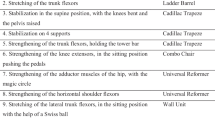Abstract.
We compared the frequency of Hypermobility Syndrome (HS) in 105 patients with urinary stress incontinence (USI) with the frequency of HS in 105 healthy controls that matched for age and parity. A Beighton score (BS) of more than 3 was used to make the clinical diagnosis of HS. Thirty-six patients (34.28%) from the USI group and 28 patients (26.66%) from the control group were diagnosed as HS. The mean BS values were 6.44±0.35 and 5.21±0.29 respectively. The difference between the two groups was statistically significant (P<0.05).
Similar content being viewed by others
References
Aksac B, Karan A, Eskiyurt N, Yalcin O (1999) The importance of the hospital vs. home delivery of the first child in stress incontinent women. First National Urogynecology congress, 8–11 June, Istanbul
Fantl JA, Cardozo L, McClish DK (1994) Estrogen therapy in the management of urinary incontinence in postmenopausal women: a meta-analysis. First report of the Hormones and Urogenital Therapy Committee. Obstet Gynecol 83:12–18
Fielding JR, Griffiths DJ, Versi E, Mulkern RV, Lee ML, Jolesz FA (1998) MR imaging of pelvic floor continence mechanisms in the supine and sitting positions. Am J Roentgenol 171:1607–1610
Gage JP, Shaw RM, Maloney FB (1995) Collagen type in dysfunctional temporomandibular joint discs. J Prosthet Dent 74:517–520
Klemps P (1997) Hypermobility. Ann Rheum Dis 56:573–575
Kuivaniemi H, Tromp G, Prockop DJ (1991) Mutations of collagen genes: causes of rare and some common diseases in humans. FASEB J 5:2052–2060
Meyer S, Schreyer A, De Grandi P, Hohlfeld P (1998) The effects of birth on urinary continence mechanisms and other pelvic floor characteristics. Obstet Gynecol 92:613–618
Mishra MB, Ryan P, Atkinson P, Taylor H, Bell J, Calver D, Fogelman I, Child A, Jackson G, Chambers JB, Grahame R (1996) Extra-articular features of benign joint hypermobility syndrome. Br J Rheumatol 35:861–866
Nichols AC, Oliver J, Renouf DV, Heath DA, Pope FM (1992) The molecular defect in a family with mild atypical osteogenesis imperfecta and extreme joint hypermobility: exon skipping caused by an 11-bp deletion from an intron in one COL1A2 allele. Hum Genet 88:627–633
Norton PA, Baker JE, Sharp HC, Warenski JC (1995) Genitourinary prolapse and joint hypermobility in women. Obstet Gynecol 85:225–228
Pandit L, Ouslander JG (1997) Postmenopausal vaginal atrophy and atrophic vaginitis. Am J Med Sci 314:228–231
Perrini F, Tallents RH, Katzberg RW, Riberio RJ, Kyrkanides S, Moss ME (1997) Generalized joint laxity and temporomandibular disorders. J Orofac Pain 11:215–220
Petros PE (1997) New ambulatory surgical methods using an anatomical classification of urinary dysfunction improve stress, urge and abnormal emptying. Int Urogynecol J Pelvic Floor Dysfunct 8:270–277
Petros PE, Ulmsten U (1999) An anatomical classification – a new paradigm for the management of urinary dysfunction in the female. Int Urogynecol J Pelvic Floor Dysfunct 10:29–35
Van Dongen PW, de Boer M, Lemmens WA, Theron GB (1999) Hypermobility and peripartum pelvic pain syndrome in pregnant South African women. Eur J Obstet Gynecol Reprod Biol 84:77–82
Verhoeven JJ, Tuinman M, van Dongen PW (1999) Joint hypermobility in African non-pregnant nulliparous women. Eur J Obstet Gynecol Reprod Biol 82:69–72
Westling L (1992) Temporomandibular joint dysfunction and systemic joint laxity. Swed Dent J Suppl 81:1–79
Author information
Authors and Affiliations
Corresponding author
Rights and permissions
About this article
Cite this article
Karan, A., Isikoglu, M., Aksac, B. et al. Hypermobility syndrome in 105 women with pure urinary stress incontinence and in 105 controls. Arch Gynecol Obstet 269, 89–90 (2004). https://doi.org/10.1007/s00404-002-0429-x
Received:
Accepted:
Published:
Issue Date:
DOI: https://doi.org/10.1007/s00404-002-0429-x




